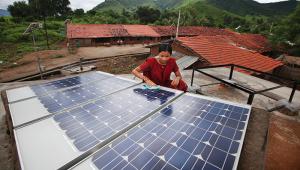As governments in developing countries strive to fill the massive infrastructure investment gap, they expect to get support from private sector.
Besides the funding, the competency of the private sector in technology and innovation is expected to add to the project’s value.
Even though public-private partnerships in infrastructure are not a new concept, their role in total infrastructure projects is still limited, especially in developing economies.
PPP implementation requires sophisticated knowledge, particularly in understanding the business aspects and risk sharing between public and private entities.
Consequently, PPP projects typically need a long time to plan and execute, so only selected big projects reach implementation stage.
PPPs are often viewed as expensive, exclusive, and only applicable to big projects bring further implications – they are perceived as suitable only for projects serving middle- to high-income users. Is that true?
Basically, PPPs are just like other infrastructure projects but are designed to have added value by utilising private resources.
Because the project uses private money, it demands profits. This is the most challenging condition in discussing PPPs to support poverty alleviation, otherwise known as pro-poor PPPs (P5s)
'Poverty is a complex issue, and it has no single cause. Providing infrastructure for the poor does not only fulfill their basic rights, but also gives them opportunities for empowerment as a way to escape from the poverty trap.'
Poverty is a complex issue, and it has no single cause. Providing infrastructure for the poor does not only fulfill their basic rights, but also gives them opportunities for empowerment as a way to escape from the poverty trap.
To have impact on poverty reduction, the infrastructure should be accessible to the poor at an affordable price. These projects also should have a standardised quality, reliable services, and efficient utilisation. But, how is a profit-oriented PPP fit for poverty alleviation policy? How can the service be provided at an affordable price?
There are some important issues in public service provision.
First, a government is responsible for providing public services but not necessarily for producing them by itself. A government can consign production of the service to a private entity while maintaining its regulatory function. PPPs can fit this model.
Second, it is important to use the right pricing mechanism to avoid inefficiency. Undervalued services will induce over-consumption, so the services must be sold at their market price. This gives PPP operators opportunity to earn fair profits without receiving a subsidy.
At economies of scale, PPPs can have profit-sharing arrangements with the government. The government can use this money to provide subsidies for the poor.
Third, servicing the poor can substantially increase risks if they are not integrated formally into the transaction or there are attached informalities, such as incomplete documents of identity, address, or social security. So, what should a government do to provide the right incentives for the private sector to participate, and at the same time make the project fit a pro-poor policy?
First, the government should differentiate between the business domain (selling the services) and the public domain (helping the poor). The operator of public services works in the business domain; it should be allowed to sell the service at its economic price. The subsidy belongs to public domain, so it should be handed out by the government to eligible recipients, not through the PPP operator.
To optimise the functions of providing basic services and empowering the poor, the government needs to identify the characteristics of the users, especially their purchasing power. It also needs to set a minimum standard for basic consumption, such as electricity (kWh per capita) or water (cubic meters per capita).
Thus, the consumers of P5s are mapped into several categories:
- Regular consumers, who can afford public services at their economic price.
- Partially subsidised consumers, who can afford the services below the minimum standard.
- Targeted consumers, who can only afford the services to fulfill their basic needs but not for empowering their economic potentials.
The first type of consumer does not receive a subsidy, the second type receives a subsidy to close the gap, and the third receives certain forms of subsidy because of their additional needs, for instance running a home business or micro, small, or medium-sized enterprise.
This approach is only feasible if consumer data are reliable and regularly updated, and tasks of the operator and regulator are separated. It is more efficient and effective to integrate this model with other relevant government programs in a cross-cutting program. This, however, requires coherent policy direction, solid coordination, and sufficient public sector capacities.
Without P5s, the government would still need to subsidise the poor, but with limited facilities, it would often mistarget beneficiaries, and inefficient consumption would result from an undervalued price.
Clearly then, utilising P5s has some valuable advantages to support poverty alleviation programs. They provide more opportunity to have additional public services.
Without PPPs, development must wait until public funds are available. They provide better quality and reliable services, as a PPP is an output-based contract. Lastly, they ensure improved efficiency and reduced mistargeting. As the PPP operator sells at economic price and users do not have an incentive to over-consume, the supply-demand equilibrium is more efficient.
Find out more about how governments and their development partners can use PPPs to promote inclusive services in the book Realizing the Potential of Public–Private Partnerships to Advance Asia’s Infrastructure Development, recently published by ADB and the Korea Development Institute.
This blog was first published on the Asian Development Bank website.














